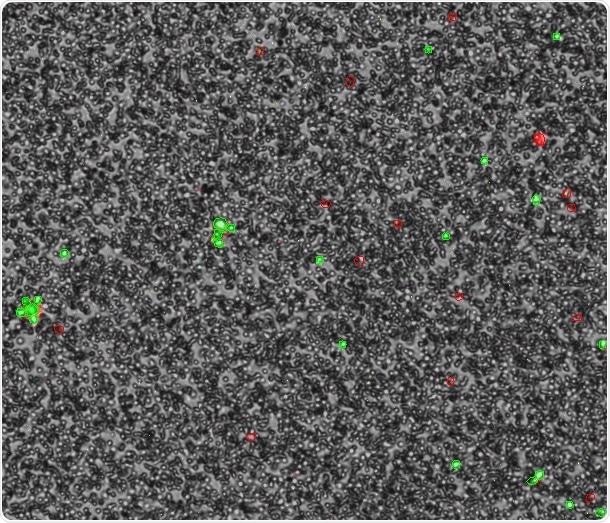Sponsored Content by DeNovix Inc.Reviewed by Louis CastelFeb 14 2022
Research settings frequently require the measurement of peripheral blood mononuclear cells (PBMCs) in a complete blood sample. This information can act as an indication of a treatment’s effectiveness or the stage/state of a disease, for instance.
Purifying a blood sample can be expensive, time-intensive and risky as it is possible to lose key samples during the numerous cleaning and purification steps. Manual counting using Trypan Blue demands a dilution and purification step to ensure the sample is manageable due to the considerable amount of erythrocytes and platelets in the sample.
As an alternative, users can skip the PBMC purification procedure when fluorescent counting on the CellDrop™ FL Automated Cell Counter, saving time and money during sample preparation and also boosting count accuracy and reproducibility in comparison to manual counting.
Eliminate Costs | Automate Cell Counting
Counting whole blood with AOPI
The CellDrop utilizes a dual-channel fluorescent system to count whole blood samples. Acridine orange (AO) and propidium iodide (PI) disregard extracellular debris and non-nucleated cells, only staining nucleated cells.
Live cells that have been stained by AO will fluoresce green while the dead cells will fluoresce red when stained with PI due to FRET quenching. A combination of the dyes can be added to diluted whole blood in a 1:1 ratio, effectively staining only the cells of interest.
Preparing whole blood for counting on CellDrop
- Dilute whole blood sample 1:100 with PBS. Note: Actual dilution factor is sample dependent and should be established empirically.
- Combine diluted whole blood with AO/PI in a 1:1 ratio for a final dilution of 1:200.
- The sample can then be pipetted into the loading groove of the CellDrop with the arm down.
- Adjust focus and exposure to check the protocol in order to ensure that the appropriate parameters are selected, then press the ‘Count’ button.
Recommended whole blood protocol
CellDrop count algorithms apply a number of parameters, which together are called a count protocol, thus allowing the user to fine-tune what is counted as a cell.
Although some adjustments may still be necessary, the settings recommended for counting PBMCs in whole blood are displayed in Table 1.
Table 1. Recommended Protocol Settings for Whole Blood. Source: DeNovix Inc.
| . |
. |
| Count Application |
AO/PI |
| Chamber Height |
100 µm |
| Dilution Factor |
200* |
| Diameter(min) |
4 µm |
| Diameter (max) |
15 µm |
| Live Roundness |
1 |
| Dead Roundness |
1 |
| Green Fluorescence Threshold |
1 |
| Red Fluorescence Threshold |
1 |
* Adjust to reflect the actual dilution as required
Ensuring reproducible results
The tips below will offer guidance that ensures the data from whole blood counts on the CellDrop is accurate and consistent:
- To extend the potency of the dyes, store AO/PI in the dark at 4 °C.
- Mix the sample thoroughly in the tube immediately prior to loading.
- Review the focus and fluorescent exposure settings prior to counting and adjust as needed.
- View the counted image after each measurement and adjust parameters as and when required.

Figure 1. CellDrop FL identifies and counts the live and dead nucleated cells in a whole blood sample. Image Credit: DeNovix Inc.
About DeNovix, Inc.
WELCOME TO DENOVIX
Award-Winning products for Life Science
Our multi-award winning products include the Reviewers’ Choice Life Science Product of the Year and Platinum Seal awarded- DS-11 Series Spectrophotometer / Fluorometer and CellDrop™ Automated Cell Counter. CellDrop is the first instrument of its kind to Count Cells Without Slides. These powerful instruments integrate patented DeNovix technology with easy-to-use software designed by life scientists for life scientists.
Researchers tell us they love the industry leading performance, smart-phone-like operation, and the flexible connectivity of the instruments. When support is needed, the DeNovix team is here to help. DeNovix received the prestigious Life Sciences Customer Service of the Year based on independent reviews posted by scientists worldwide!
CellDrop: Sustainable laboratory product of the year
The CellDrop Automated Cell Counter has been awarded Sustainable Laboratory Product of the Year in the SelectScience® Scientists’ Choice Awards®!
CellDrop’s patented DirectPipette™ technology distinguishes it as the only cell counter to eliminate the need for cell counting slides. This innovation saves millions of single-use plastic slides from use and disposal each year.
Sponsored Content Policy: News-Medical.net publishes articles and related content that may be derived from sources where we have existing commercial relationships, provided such content adds value to the core editorial ethos of News-Medical.Net which is to educate and inform site visitors interested in medical research, science, medical devices and treatments.